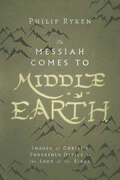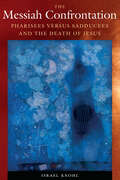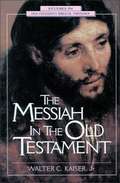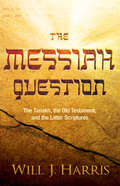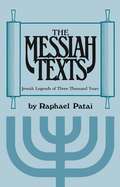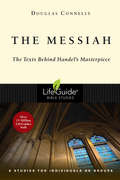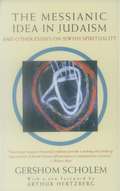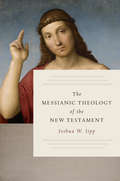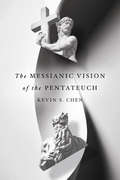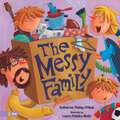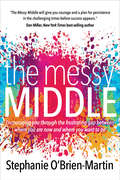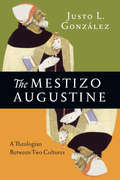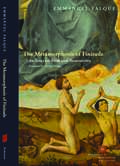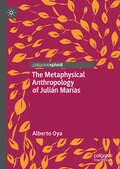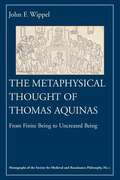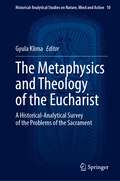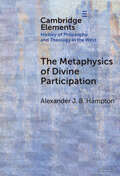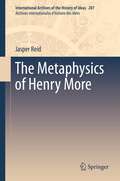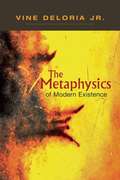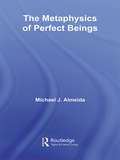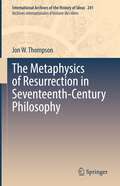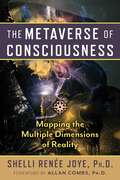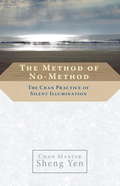- Table View
- List View
The Messiah Comes to Middle-Earth: Images of Christ's Threefold Office in The Lord of the Rings (Hansen Lectureship Ser.)
by Philip RykenHow can we grasp the significance of what Jesus Christ did for us? Might literature help us as we seek to understand the Christian faith?J.R.R. Tolkien’s The Lord of the Rings has generated much discussion about the relationship between Christianity and literature. It is well known that Tolkien disliked allegory. Yet he acknowledged that his work is imbued with Christian symbolism and meaning.Based on the inaugural Hansen Lectureship series delivered at the Marion E. Wade Center by Philip Ryken, this volume mines the riches of Tolkien’s theological imagination. In the characters of Gandalf, Frodo, and Aragorn, Ryken hears echoes of the threefold office of Christ—his prophetic, priestly, and royal roles. Guided by Ryken, readers will discover that they can learn much about the one who is the true prophet, priest, and king through Tolkien's imaginative storytelling.
The Messiah Confrontation: Pharisees versus Sadducees and the Death of Jesus
by Dr. Israel KnohlThe Messiah Confrontation casts new and fascinating light on why Jesus was killed. Grounded in meticulous research on the messianism debates in the Bible and during the Second Temple period, biblical scholar Israel Knohl argues that Jesus&’s trial was in reality a dramatic clash between two Jewish groups holding opposing ideologies of messianism and anti-messianism, with both ideologies running through the Bible. The Pharisees (forefathers of the rabbinic sages) and most of the Jewish people had a conception of a Messiah similar to Jesus: like the prophets and most psalmists, they expected the arrival of a godlike Messiah. However, the judges who sentenced Jesus to death were Sadducees, who were fighting with the Pharisees largely because they repudiated the Messiah idea. Thus, the trial of Jesus was not a clash between Jewish and what would become Christian doctrines but a confrontation between two internal Jewish positions—expecting a Messiah or rejecting the Messiah idea—in which Jesus and the Pharisees were actually on the same side. Knohl contends that had the assigned judges been Pharisees rather than Sadducees, Jesus would not have been convicted and crucified. The Pharisees&’ disagreement with Jesus was solely over whether Jesus was the Messiah—but historically, for Jews, arguing about who was or wasn&’t the Messiah was not uncommon.The Messiah Confrontation has far-reaching consequences for the relationship between Christians and Jews.
The Messiah In The Old Testament
by Walter C. KaiserOld Testament texts that point to the coming of the Messiah are traditionally interpreted either from the viewpoint of their New Testament fulfillment (evangelicalism) or their linguistic and grammatical distinctiveness within the Hebrew Bible (non-conservative). The Messiah in the Old Testament considers another important line of interpretation that has been neglected in building an Old Testament theology. It approaches Israel's concept of the Messiah as a developing theme and shows how a proper grasp of the textual meaning at each stage of Old Testament revelation is necessary for understanding messianic prophecy. Beginning in the Pentateuch and working through the Old Testament to the Minor Prophets, the author delineates texts that are direct messianic prophecies and examines their meaning and development within the flow of God's plan. The reader will gain an understanding of God's process for bringing the Messiah to earth through the nation of Israel, and of his intent to bring the saving knowledge of Christ to the World through them.
The Messiah Question: The Tanakh, the Old Testament, and the Latter Scriptures
by Will J. HarrisFor the last two thousand years, three unanswerable questions have perplexed Jewish religious scholars: When will Messiah appear? (Jews, in general, do not believe He has come.)Why were the Jews dispersed from their nation for two thousand years? (Israel&’s statehood was only recently restored, in 1948.)When in the biblical timeline does Messiah appear? (Again, most Jews are still waiting for Messiah to come the first time.) The Messiah Question answers each question by exploring the Tanakh (Jewish Bible), historical rabbinical commentary, &“Latter Scriptures&” (New Testament), and Bible prophecies, explaining Messiah&’s appearance in both the Tanakh and rabbinical texts. Thus The Messiah Question is a great witnessing tool for Messianic Jews or Gentile believers seeking to reach unbelieving Jews for Yeshua (Jesus). It will amplify your knowledge of the Old Testament and fortify your faith in God&’s plan for humanity.
The Messiah Texts: Jewish Legends of Three Thousand Years
by Raphael PataiFollowing a detailed introduction to the world of messianic ideology and its significance in Jewish history, The Messiah Texts traces the progress of the messianic legend from its biblical beginnings to contemporary expressions.Renowned scholar Raphael Patai has skillfully selected passages from a voluminous literature spanning three millennia. Using his own translations from Hebrew, Aramaic, Arabic, Latin, and other original texts, Patai excerpts delightful folk tales, apocalyptic fantasies, and parables of prophetic power. All are central to the understanding of a magnificent heritage. patai also investigates the false messiahs who have appeared throughout Jewish history, the modern Messiah-influenced movements such as reform Judaism and Zionism, and the numerous reasons put forth by the various branches of Judaism as to why the Messiah has not yet appeared.
The Messiah of Morris Avenue
by Tony HendraIn The Messiah of Morris Avenue, Tony Hendra—the acclaimed satirist and New York Times bestselling author of Father Joe—poses the question: would we recognize the messiah if he appeared today? And delivers, in the words of Frank McCourt, “just what the country needs now—a good dose of merriment in the face of crawthumping righteousness.”In the not so distant future, the tide of righteousness—in the form of executions, barking evangelists, tank-like SUVs, and a movie industry run entirely by the Christian right—has swept the nation. Aside from the non-white, the non-Christian, and the non-wealthy, all are believers.Among the skeptics is a washed-up journalist named Johnny Greco, who hears of a media-shy young man known as “Jay” roaming through ghettos, healing the sick, and tossing off miracles. Soft-spoken and shabbily dressed, Jay is an unlikely savior for this anxious and intolerant America.But as he makes his rounds, gathers followers, and makes furious enemies among the righteous powers that be, Johnny finds it harder and harder to doubt him.
The Messiah: The Texts Behind Handel's Masterpiece (LifeGuide Bible Studies)
by Douglas ConnellyProphets prophesied about him. Angels and shepherds rejoiced at his birth. Friends cried for joy at his resurrection. And we still celebrate him today. He is Jesus, the Messiah. Perfect for Advent or Lent, this eight-session LifeGuide Bible Study guide explores some of the key passages in the Old Testament about the Messiah and their completion in the life and saving work of Jesus. These passages have had a profound effect on the imagination and worship of Christians for two thousand years, leading George Frederic Handel to write one of the greatest expressions of worship and adoration—his oratorio, the Messiah. We hear parts of it sung every year during the Christmas season, but what many listeners fail to realize is that the entire text of Handel's Messiah is drawn from Scripture—and many of the Old Testament passages that shaped Israel's hope for their Redeemer are included in that text. This guide leads you through Scripture passages used in Handel's work that highlight who Jesus is and what he came to do. It might change the way you listen to the Messiah. Even more, it might change the way you live. For over three decades LifeGuide Bible Studies have provided solid biblical content and raised thought-provoking questions—making for a one-of-a-kind Bible study experience for individuals and groups. This series has more than 130 titles on Old and New Testament books, character studies, and topical studies.
The Messianic Idea in Judaism: And Other Essays on Jewish Spirituality
by Gershom ScholemGershom Scholem was the master builder of historical studies of the Kabbalah. When he began to work on this neglected field, the few who studied these texts were either amateurs who were looking for occult wisdom, or old-style Kabbalists who were seeking guidance on their spiritual journeys. His work broke with the outlook of the scholars of the previous century in Judaica--die Wissenschaft des Judentums, the Science of Judaism--whose orientation he rejected, calling their "disregard for the most vital aspects of the Jewish people as a collective entity: a form of "censorship of the Jewish past." The major founders of modern Jewish historical studies in the nineteenth century, Leopold Zunz and Abraham Geiger, had ignored the Kabbalah; it did not fit into their account of the Jewish religion as rational and worthy of respect by "enlightened" minds. The only exception was the historian Heinrich Graetz. He had paid substantial attention to its texts and to their most explosive exponent, the false Messiah Sabbatai Zevi, but Graetz had depicted the Kabbalah and all that flowed from it as an unworthy revolt from the underground of Jewish life against its reasonable, law-abiding, and learned mainstream. Scholem conducted a continuing polemic with Zunz, Geiger, and Graetz by bringing into view a Jewish past more varied, more vital, and more interesting than any idealized portrait could reveal.--from the Foreword by Arthur Hertzberg, 1995From the Trade Paperback edition.
The Messianic Theology of the New Testament
by Joshua W. JippOne of the earliest Christian confessions—that Jesus is Messiah and Lord—has long been recognized throughout the New Testament. Joshua Jipp shows that the New Testament is in fact built upon this foundational messianic claim, and each of its primary compositions is a unique creative expansion of this common thread. Having made the same argument about the Pauline epistles in his previous book Christ Is King: Paul&’s Royal Ideology, Jipp works methodically through the New Testament to show how the authors proclaim Jesus as the incarnate, crucified, and enthroned messiah of God. In the second section of this book, Jipp moves beyond exegesis toward larger theological questions, such as those of Christology, soteriology, ecclesiology, and eschatology, revealing the practical value of reading the Bible with an eye to its messianic vision. The Messianic Theology of the New Testament functions as an excellent introductory text, honoring the vigorous pluralism of the New Testament books while still addressing the obvious question: what makes these twenty-seven different compositions one unified testament?
The Messianic Vision of the Pentateuch
by Kevin S. ChenDid Moses write about Jesus?The Messianic Vision of the PentateuchThe Messianic Vision of the Pentateuch
The Messy Family
by Katherine Pebley O'NealOh no! Friends are coming, and the Messys must team up to clean up. But when an intricate cobweb and new litter of kittens take their eyes off the ball, the family just hopes no one opens any closets or peeks under any beds! In the end, they learn the Albrights don’t come because the Messys are perfect—they come for the fun and fellowship of friends who love God!
The Messy Middle: Encouraging You Through the Frustrating Gap Between Where You Are Now and Where You Want to Be
by Stephanie O’Brien-MartinThe Messy Middle addresses something that is far too often ignored: the struggle that always comes when doing something significant to advance the Kingdom of God. Stephanie O’Brien shares a wide variety of true stories that will encourage and inspire the readers to work through the challenging parts of important work. She provides encouragement and empowers readers to help them make it through the challenges that come when doing any great work. Readers will learn how to keep the faith and stay on course, even when the middle seems too messy.
The Mestizo Augustine: A Theologian Between Two Cultures
by Justo L. GonzálezFew thinkers have been as influential as Augustine of Hippo. His writings, such as Confessions and City of God, have left an indelible mark on Western Christianity. He has become so synonymous with Christianity in the West that we easily forget he was a man of two cultures: African and Greco-Roman. The mixture of African Christianity and Greco-Roman rhetoric and philosophy gave his theology and ministry a unique potency in the cultural ferment of the late Roman empire. Augustine experienced what Latino/a theology calls mestizaje, which means being of a mixed background. Cuban American historian and theologian Justo González looks at the life and legacy of Augustine from the perspective of his own Latino heritage and finds in the bishop of Hippo a remarkable resource for the church today. The mestizo Augustine can serve as a lens by which to see afresh not only the history of Christianity but also our own culturally diverse world.
The Metamorphosis of Finitude: An Essay on Birth and Resurrection (Perspectives in Continental Philosophy)
by Emmanuel FalqueThis book starts off from a philosophical premise: nobody can be in the world unless they are born into the world. It examines this premise in the light of the theological belief that birth serves, or ought to serve, as a model for understanding what resurrection could signify for us today. After all, the modern Christian needs to find some way of understanding resurrection, and the dogma of the resurrection of the body is vacuous unless we can relate it philosophically to our own world of experience. Nicodemus first posed the question "How can anyone be born after having grown old?Can one enter a second time into the mother's womb and be born?" This book reads that problem in the context of contemporary philosophy (particularly the thought of Husserl, Heidegger, Sartre, Merleau-Ponty, and Deleuze). A phenomenology of the body born "from below" is seen as a paradigm for a theology of spiritual rebirth, and for rebirth of the body from "on high." The Resurrection changes everything in Christianity—but it is also our own bodies that must be transformed in resurrection, as Christ is transfigured. And the way in which I hope to be resurrected bodily in God, in the future, depends upon the way in which I live bodily today.
The Metaphysical Anthropology of Julián Marías (Palgrave Frontiers in Philosophy of Religion)
by Alberto OyaThis book provides a detailed account of Julián Marías’s metaphysical anthropology with the ultimate aim of offering a coherent and systematic analysis of Marías’s argumentation for claiming that the conscious hope for Christian salvation through resurrection — and with it the hope that Jesus Christ did actually resurrect, and more generally the hope that Christian revelation is true — is justified not because the certainty or the likelihood that this salvation will, as a matter of fact, actually occur, but because this hope amounts to a self-affirming exercise, a conscious endorsement of human reality, and as such a sign of authenticity.
The Metaphysical Thought of Thomas Aquinas
by John F. WippelThis volume offers a presentation of Aquinas's metaphysical thought. It is based upon an examination of his texts organized according to the philosophical order as he himself described it, rather than according to the theological order.
The Metaphysical World of Isaac Newton: Alchemy, Prophecy, and the Search for Lost Knowledge
by John ChambersNewton’s heretical yet equation-incisive writings on theology, spirituality, alchemy, and prophecy, written in secret alongside his Principia Mathematica • Shows how Newton’s brilliance extended far beyond math and science into alchemy, spirituality, prophecy, and the search for lost continents such as Atlantis • Explains how he was seeking to rediscover the one true religion that existed prior to the Flood of Noah, when science and spirituality were one • Examines Newton’s alternate timeline of prehistory and his study of prophecy through the Book of Revelations, including his prediction of Apocalypse in the year 2060 Isaac Newton (1643-1727) is still regarded by the world as the greatest scientist who ever lived. He invented calculus, discovered the binomial theorem, explained the rainbow, built the first reflecting telescope, and explained the force of gravity. In his famous masterpiece, Principia Mathematica, he described the mechanics of the physical universe with unimagined precision, proving the cosmos was put together according to laws. The perfection of these laws implied a perfect legislator. To Newton, they were proof that God existed. At the same time Newton was writing Principia Mathematica, he was writing a twin volume that he might have called, had it been completed, Principia Theologia--Principles of Theology. This other masterpiece of Newton, kept secret because of the heresies it contained, consists of thousands of essays providing equation-incisive answers to the spiritual questions that have plagued mankind through the ages. Examining Newton’s secret writings, John Chambers shows how his brilliance extended into alchemy, spirituality, the search for lost continents such as Atlantis, and a quest to uncover the “corrupted texts” that were rife in the Bibles of his time. Although he was a devout Christian, Newton’s work on the Bible was focused not on restoring the original Jewish and Christian texts but on rediscovering the one true religion that existed prior to the Flood of Noah, when science and spirituality were one. The author shows that a single thread runs through Newton’s metaphysical explorations: He is attempting to chart the descent of man’s soul from perfection to the present day. The author also examines Newton’s alternate timeline of ancient history and his study of prophecy through the Book of Revelations, including his prediction of an Apocalypse in the year 2060 followed by a radically transformed world. He shows that Newton’s great hope was that these writings would provide a moral compass for humanity as it embarked upon the great enterprise that became our technological world.
The Metaphysics and Theology of the Eucharist: A Historical-Analytical Survey of the Problems of the Sacrament (Historical-Analytical Studies on Nature, Mind and Action #10)
by Gyula KlimaThis volume is about the most mind-boggling sacrament of the Christian faith, also referred to as the Sacrament of the Altar, the Eucharist: in its Roman Catholic interpretation, the conversion of the substance of the bread and wine into the body and blood of Christ for Holy Communion. The challenge of providing a rational interpretation of this doctrine of faith proved to be one of the most contentious issues in the Western history of ideas, apparently going against self-evident metaphysical principles (requiring accidents existing without a substance, and a body in several places at the same time, etc.), and dividing schools of thought, indeed, eventually, warring religious factions. The volume addresses both the metaphysical, theoretical issues involved in this challenge and the historical, theological developments of how meeting this challenge played out first in the schools and even later in religious schisms, leading to the paradigmatic shift from medieval to modern forms of thought. The essays of the volume derive from the lectures of an eponymous international conference held in Budapest, Hungary, which was also the occasion of founding the Society for the History of European Ideas (SEHI); accordingly, the book is the first volume of the annual Proceedings of the SEHI. This book is aimed just as much at laymen and religious scholars seeking a better understanding of their faith as at anyone seeking this understanding with a non-religious attitude.
The Metaphysics of Divine Participation (Elements In the History of Philosophy and Theology in the West)
by Alexander J. HamptonParticipation has been central to the story of Western philosophy and theology for at least two millennia. It has been employed to conceptualise the relationship between God and creation, between universals and particulars, and between the One and the many. This Element approaches the concept systematically to acquire an appreciation of its breadth and depth under four fundamental themes: creation and the divine ideas, incarnation and salvation, being and multiplicity, and the human activities of naming, knowing and making. In doing so it examines some of the key thinkers in the participatory tradition, including Augustine, Irenaeus, Aquinas and Nicholas of Cusa. Readers will be introduced to the key contours and manifestations of participatory metaphysics, and its role in Christianity's self-articulation. Together, these considerations will demonstrate how the metaphysics of participation has shaped the Christian tradition.
The Metaphysics of Henry More
by Jasper ReidThe book surveys the key metaphysical contributions of the Cambridge Platonist, Henry More (1614-1687). It deals with such interwoven topics as: the natures of body and spirit, and the question of whether or not there is a sharp ontological division between them; the nature of spatial extension in relation to each; the composition and governance of the physical world, including More's theories of Hyle, atoms, vacuum, and the Spirit of Nature; and the life of the human soul, including its pre-existence. It approaches these topics and the systematic connections between them both historically and analytically, and seeks to do justice to the ways in which More's system developed and changed--sometimes quite dramatically--over the course of his long career. It also explores More's intellectual relations with both his own inspirations (Plotinus, Origen, Ficino, Descartes, etc.) and with those who responded, whether positively or negatively, to his work (Leibniz, Locke, Boyle, Newton, etc.).
The Metaphysics of Modern Existence
by David E. Wilkins Vine Deloria Jr. Daniel R. WildcatVine Deloria Jr., named one of the most influential religious thinkers in the world by Time, shares a framework for a new vision of reality. Bridging science and religion to form an integrated idea of the world, while recognizing the importance of tribal wisdom, The Metaphysics of Modern Existence delivers a revolutionary view of our future and our world. David E. Wilkins holds the McKnight Presidential Professorship in American Indian Studies at the University of Minnesota. Daniel R. Wildcat is the director of the American Indian studies program and the Haskell Environmental Research Studies Center at Haskell Indian Nations University.
The Metaphysics of Perfect Beings (Routledge Studies in the Philosophy of Religion #Vol. 5)
by Michael J. AlmeidaThe Metaphysics of Perfect Beings addresses the problems an Anselmian perfect being faces in contexts involving unlimited options. Recent advances in the theory of vagueness, the metaphysics of multiverses and hyperspace, the theory of dynamic or sequential choice, the logic of moral and rational dilemmas, and metaethical theory provide the resources to formulate the new challenges and the Anselmian responses with an unusual degree of precision. Almeida shows that the challenges arising in the unusual contexts involving unlimited options sometimes produce metaphysical surprise.
The Metaphysics of Resurrection in Seventeenth-Century Philosophy (International Archives of the History of Ideas Archives internationales d'histoire des idées #241)
by Jon W. ThompsonThis book provides a new account of the emergence of the philosophy of personal identity in the early modern period. Reflection on personal identity is often thought to have begun in earnest with John Locke’s famous consciousness-based account, published in the 2nd Edition of the Essay in 1694. The present work argues that we ought to understand modern notions of personal identity, including Locke’s own, as emerging from within debates about the metaphysics of resurrection across the seventeenth century. It recovers and analyses theories of personal identity and resurrection in Locke and Leibniz, as well as largely-forgotten theories from the Cambridge Platonists, Thomas Jackson, and Francisco Suárez. The book narrates a time of radical change in conceptions of personal identity: the period begins with a near-consensus on hylomorphism, according to which the body is an essential metaphysical part of the person. The re-emergence of platonism in the period then undermines the centrality of the body for personal identity, and this lays the groundwork for a more thoroughly ‘psychological’ account of personal identity in Locke. This work represents the first scholarly study to thoroughly situate early modern conceptions of personal identity, embodiment, and the afterlife within the context of late scholasticism. Finally, due to its focus on the arguments of the authors in question, the work will be of interest to philosophers of religion as well as historians of philosophy.
The Metaverse of Consciousness: Mapping the Multiple Dimensions of Reality
by Shelli Renée Joye• Develops the concept of the metaverse, the &“transcendental universe,&” composed of additional hidden dimensions operating in parallel with space and time• Integrates and maps the theories of consciousness developed by Carl Jung, David Bohm, Pierre Teilhard de Chardin, and other scientists• Offers the reader a path into the hidden dimensions through detailed maps of psyche, mind, and cosmosThe "metaverse"—as this wider universe is now coming to be known—is rooted in one interconnected consciousness that encompasses space and time as well as previously unknown dimensions only recently detected. In this book, Shelli Renée Joye, Ph.D., offers ways in which to visualize, enter, and explore a multitude of these transcendent, nonspatial, and nontemporal states and stages of consciousness as she reveals vast webs of interlinked consciousness forming a single universal psyche.Joye integrates the ideas of modern scientist-philosophers who view reality as a projection of a single multidimensional consciousness: Carl Jung and his concept of the psychoids, Pierre Teilhard de Chardin and his vision of an integrated noosphere of consciousness, and the quantum maps of consciousness developed by Karl Pribram and David Bohm. The book culminates with a call to explore transcendental consciousness by developing and following our own uniquely personal paths with which we too can enter the wider dimensions of awareness in the metaverse.
The Method of No-Method: The Chan Practice of Silent Illumination
by Sheng YenHere is a spiritual practice uncomplicated enough for anyone to learn, yet rich enough to be worked with for a lifetime. The traditional Chan (Chinese Zen) practice called Silent Illumination begins with nothing more than putting aside all thoughts except the awareness of oneself "just sitting." It's so simple in execution that it has sometimes been called the "method of no-method"--yet simple as it is, the practice is subtle and profound, with the potential for ever subtler refinements as the practitioner moves toward mastery of it. When fully penetrated, this radical form of emptying one's busy mind-stream leads to perception of the vast ocean of pure awareness.
